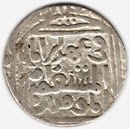Medieval India Coinage
Map of Medieval India, Courtesy Government of India
Description | Obverse | Reverse
Coin of Nasiru-d-din Mahmud
1246 - 1266 AD
Coin of Ghiyasu-d-din Balban
1266 - 1287 AD
Coins of the Delhi Sultanate
Coins of the Khiljis
The coins of the Tughlaqs (1320-1412 AD) were superior in design and execution to those of the Khiljis. Muhammed bin Tughlaq (1325-1351 AD), took personal interest in his coinage, however, his monetary experiments were a failure and the cause of much misery. The first experiment was to make his coinage reflect the gold/silver price ratio prevailing in the free market. When this experiment failed the old gold and silver coins of about 11 grams were reintroduced. The next experiment was inspired by Chinese paper currency which had spurred the development of trade and commerce. Tughlaq attempted to establish a fiduciary system of coinage between 1329 to 1332 AD. He attempted to issue tokens of brass and copper. These tokens bore the legends such as : 'Sealed as a tanka of fifty ganis' together with appeals such as 'He who obeys the Sultan, obeys the Compassionate'. Mass forgeries rendered the experiment a total disaster and Tughlaq, to his credit, redeemed all tokens, forged or genuine, in specie. It may be noted that the experiments of Tughlaq were genuine experiments: while they were forced on the populace, they were not dictated by a bankrupt treasury. Gold coins were issued in very large numbers during the reign of Muhammed bin Tughlaq, thereafter gold coins became scarce. By the time of the Lodhis, coins were struck almost exclusively of copper and billon. In the provinces, the Bengal Sultans, the Jaunpur Sultans, the Bahamanis of the Deccan, the Sultans of Malwa, the Sultans of Gujarat, etc. struck coins. In the South, however, the Vijayanagar Empire evolved coinage of different metrology and design which was to remain as a standard in the region and influence coin design up to the 19th Century.
Silver Coins, Malwa
The Vijayanagar Empire
In the South, the Vijayanagar contemporaries of the Delhi Sultanate and Mughals, were the other dynasty whose currency presents a rare example of a standardised issue which later provided a model for the European and English trading companies. The Kingdom of Vijayanagar was founded around 1336 AD by Harihara and Bukka in the region south of the River Krishna. The Vijayanagar period saw the advent of European traders especially the Portuguese. Krishnadevaraya encouraged foreign trade and this necessitated wider use of currency. Coins of the Vijayanagar kingdom was largely struck in gold and copper. Most Vijayanagar gold coins bore a sacred image on the obverse and the royal legend on the reverse. Amongst the significant gold coins of the Vijayanagar Empire were those bearing the image of the deity of Tirupati, i.e., Lord Venkatesvara represented either singly or with his two consorts. These coins inspired the 'Single Swami' Pagodas of the Dutch and French and the 'Three Swami' Pagodas of the English East India Company.
Coins of the Vijayanagar Empire
Pagoda, East India Company inspired by the coins of the Vijayanagar Empire
Ancient | Medieval | Mughal | Late Pre-Colonial | British India | Republic India | Other Issues















No comments:
Post a Comment